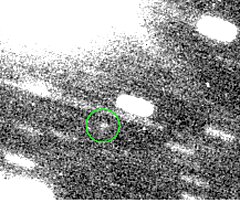Francisco (księżyc)
| ||
 Księżyc Francisco (w kółku) na zdjęciu wykonanym przez odkrywców | ||
| Planeta | Uran | |
| Odkrywca | Matthew Holman, John Kavelaars, Dan Milisavljevic, Tommy Grav[1] | |
| Data odkrycia | 13 sierpnia 2001[1] | |
| Tymczasowe oznaczenie | S/2001 U3 | |
| Charakterystyka orbity | ||
| Półoś wielka | 4 282 900 km[2] | |
| Mimośród | 0,1324[2] | |
| Okres obiegu | 267,09 d[2] | |
| Nachylenie do ekliptyki | 147,250°[2] | |
| Długość węzła wstępującego | 100,738°[2] | |
| Argument perycentrum | 140,644°[2] | |
| Anomalia średnia | 3,202°[2] | |
| Własności fizyczne | ||
| Średnica równikowa | 22 km[3] | |
| Średnia gęstość | 1,5 g/cm³[3] | |
| Albedo | 0,04[3] | |
| Jasność obserwowana (z Ziemi) | 25,0m[3] | |
Francisco (Uran XXII) – mały, nieregularny księżyc planety Uran. Odkryli go Matthew Holman, John Kavelaars, Dan Milisavljevic i Tommy Grav w Międzyamerykańskim Obserwatorium Cerro Tololo w 2001 roku, jednak potwierdzenie tego odkrycia i wyliczenie elementów orbity nastąpiło dopiero w 2003 roku[4].
Jest to najbardziej wewnętrzny z nieregularnych księżyców Urana, porusza się ruchem wstecznym.
Nazwa pochodzi od imienia jednego z bohaterów sztuki Burza Szekspira.
Zobacz też
Przypisy
- ↑ a b Francisco (ang.). W: Solar System Exploration [on-line]. NASA. [dostęp 2018-12-25].
- ↑ a b c d e f g Planetary Satellite Mean Orbital Parameters (ang.). Jet Propulsion Laboratory, 2011-12-14. [dostęp 2012-10-28].
- ↑ a b c d Planetary Satellite Physical Parameters (ang.). Jet Propulsion Laboratory, 2015-02-19. [dostęp 2016-02-11].
- ↑ IAUC 8216 (ang.). W: IAU Central Bureau for Astronomical Telegrams [on-line]. Międzynarodowa Unia Astronomiczna, 2003-10-07. [dostęp 2016-02-11].
Media użyte na tej stronie
This is a revised version of Solar_System_XXIX.png.
This image of Uranus was compiled from images returned Jan. 17, 1986, by the narrow-angle camera of Voyager 2. The spacecraft was 9.1 million kilometers (5.7 million miles) from the planet, several days from closest approach. This picture has been processed to show Uranus as human eyes would see it from the vantage point of the spacecraft. The picture is a composite of images taken through blue, green and orange filters. The darker shadings at the upper right of the disk correspond to the day-night boundary on the planet. Beyond this boundary lies the hidden northern hemisphere of Uranus, which currently remains in total darkness as the planet rotates. The blue-green color results from the absorption of red light by methane gas in Uranus' deep, cold and remarkably clear atmosphere.
Three images showing the Uranian satellite S/2001 U2 (Ferdinand). The full CTIO observation set are sub-divided into three batches that were shifted at the rate and direction of the motion of Uranus and then recombined. The satellite is indicated by the circle in each image and can be seen moving from left to right. The elongated features in the images are stars that have been smeared out by the shifting process.



